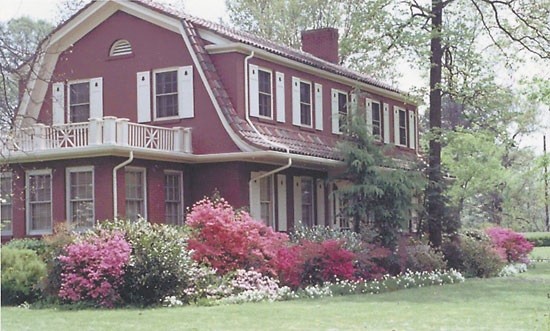Andrew Hale Franklin (1892-1953) had worked at downtown Knoxville grocery stores as early as 1915, often listed as a driver; but, by 1924, the City Directory listed him as a grocer in Fountain City. By 1926, his store was called the Fountain City Grocery and occupied the corner of Colonial Circle and Broadway (now 5425 North Broadway).
His success enabled him to envision a new, larger home for his family, and he acquired property on Terrace View Drive in present-day Harrill Hills for that purpose. According to family tradition, the builder and Fountain City’s leading grocer made an arrangement that was not so unusual for its time. Hale, as he preferred to be called, agreed to barter a weekly supply of groceries periodically in exchange for part of the construction cost and the building materials.

Fountain City Grocery Store: The Franklins and their extended family are shown in this 1917 photograph: Hale Franklin, Walter Brooks, Florence Brooks (holding Ellis), Vada Franklin, Pauline Franklin, Lillian Brooks, White and Mollie Tolbert. (C.M. McClung Historical Collection #200-006-007)
The arrangement enabled him to finance deluxe features found in very few homes at the time, such as the all-brick exterior, steel columns and I-beams in the basement to support the two floors above and a concrete tile roof.
As she was just learning to drive, Mrs. Franklin did not like having to back the car out of the driveway. Her doting husband built her a drive-through brick garage, which may have been the only one at a residence in the area, so she never needed to use the reverse gear.
The home’s deluxe interior included an elegant walnut mantel with decorative stone and inlaid tile hearth surrounding the living room fireplace, arched entries in the living and dining rooms, a grand staircase, textured plaster finish on all walls and ceilings, cedar-lined closets, both a built-in ceramic tile shower with arched opening and a unique curved bathtub in the master bath with a separate dressing room for his wife, plus a laundry chute for added convenience.
Franklin and his wife, the former Vada Alice Tolbert (1893-1968), and their two daughters, Pauline and Lorraine, moved into their new home in 1923. The house seems to have been the first house built in Harrill Hills that is still standing and occupied.
Harrill Hills was built in three phases. There is the Gaines M. Harrill (1844-1921) period when the acreage was mostly in farmland and forest. N.L. Hicks’ “The History of Fountain City” (2000) says, “In 1898 G.M. Harrill bought from J.M. Crawford about 80 acres of land. In 1888, according to records at the Register of Deeds office, Harrill bought several acres lying east of Jacksboro Road from the estate of John Gault. This did not include about 40 acres surrounding the brick house (Crawford House). The land passed on to the next generation of Harrills who sold it in 1927 to an investment company for a subdivision called Harrill Hills. They lost the property and it was developed by another company.”
That other company was the Harrill Hills Company Inc. Their plot map calls the development the “Harrill Hills First and Second Units, 1927,” designed by Wilkinson and Wilkinson. Their development covered a large area from Forest Lane at the north and Gaineswood Road on the south, bounded on the east by Brier Cliff Road and on the west by Jacksboro Pike. The development contained almost 300 building sites.
The Harrill Hills Company Inc. was the developer, with A.M. Hill the sales agent. Interestingly, Wilkinson and Wilkinson, the design firm, hired J. Boyd McCalla (1884-1930) and Felix G. Phillips (1853-1938) as civil engineers for the project. McCalla was the commissioner of highways and improvements for the city of Knoxville before becoming a private engineer.
Phillips was the civil engineer for the Fountain Head Railway project in 1890. The 5.25-mile railway had been built in a record time of five months as a tribute to both the engineering and the workforce. He also designed scenic, heart-shaped Fountain City Lake. Although he was a native of Lebanon, Ky., Phillips lived in Knoxville more than 50 years. His first local engineering work was Luttrell Street in North Knoxville, and he later surveyed the site for Highland Memorial Cemetery and helped plan its development.
The third phase in the development of Harrill Hills, sometimes called Harrill Heights, was developed by William C. Dawn and W.W. “Bill” Mullendore much later.
Hale Franklin, an early Fountain City visionary, had sown the seed for the development of one of Fountain City’s most beautiful neighborhoods.
The Franklin House at 3701 Terrace View was more recently the home of Brent and Robin Wilhoit. Robin Wilhoit is the widely-known news co-anchor at WBIR, Channel 10. Local architect Gregory Terry is now the owner.


